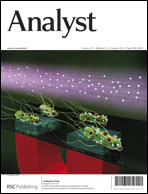D-optimal design of an untargeted HS-SPME-GC-TOF metabolite profiling method
Abstract
In recent times we have seen the development of many “-omics” technologies. One of the youngest is undoubtedly metabolomics, which aims to define the whole chemical fingerprint unique to each specific organism. The development and optimisation of an untargeted high-throughput method capable of investigating the volatile fraction of a biological system represents a crucial step for the success of such holistic approaches, and specific optimisation criteria must be developed in connection with suitable experimental designs. In this paper experimental designs (D-optimal) were applied for the first time as an automatic optimisation tool to an untargeted HS-SPME-GC-TOF method. In this case, optimal conditions correspond to a maximal number of detected features, in order to provide a fingerprint that is as complete as possible. The system under study is the grape berry. Four variables were considered: the type of fibre,


 Please wait while we load your content...
Please wait while we load your content...